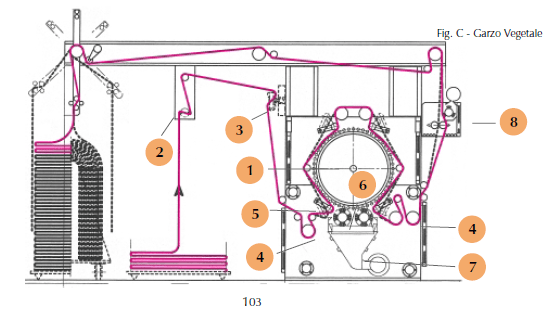© 2025 All rights reserved
Project by UsedTextilemachines.eu
Don't have an account yet? Register
Do you already have an account? Go to login Click here
Don't have an account yet? Register
Do you already have an account? Go to login Click here
Looking for the best opportunities to satisfy the customer:
Mobile Phone: +393319020189
Working hours: 09.30 / 12.30 - 16.00 / 18.00 From Monday to Friday.
Vegetable raising is usually used to treat the fabrics of
greater value. It is carried out wet as this facilitates the extraction of the
fibers, which remain intact, obtaining less weight loss and particular shine
of the woolen fabric.
For this processing, vegetable thistles are used (see figure A), the inflorescence
dry, oval, elongated and covered with elastic tips e
uncinate, of a plant belonging to the dipsacaceae family.


The raising machine consists of
a large drum (see figure C, point 1) of about 1.5 m in diameter, on which they are fixed
of the strips in which the thistles are inserted (see figure B, point 1).
The strips, about 20 cm long, contain 3-4 thistles depending on the length and are fixed to the drum
on a support that allows the thistles to rotate on themselves (fig. B, 2), they are arranged inclined
with respect to the axis of the drum, to ensure that the thistles act uniformly both on the weft and
on the warp (fig. B, 3).

The fabric passes:
through the tensioning cylinder (fig. C, 2) and the center piece (fig. C, 3),
it is transported by a series of rubber-coated inlet and outlet cylinders (fig. C, 4).
Its pressure on the raising drum is regulated by four dancing cylinders (fig. C, 5).
Two brushes (fig. C, 6) for cleaning the thistles are placed under the drum.
A special vacuum cleaner (fig. C, 7) removes the fluff extracted from the thistles.
A brush (fig. C, 8) with relative vacuum cleaner finishes the hair straight, at the end of the path.
When finished, the piece is folded or rolled up on a special beam.
The effect of raising the pile and counter-pile is given by the drum which can rotate in two directions, with
speed higher or lower than that of the fabric.
The intensity of the raising depends on
the pressure of the dancing cylinders on the fabric;
the condition of thistles. The new and very elastic ones produce a more intense raising.
The raiser must:
place the wet cloth on the gauze;
sew the tail of the last piece with the head of the first to form the ring to be treated;
carry out constant checks on
• the state of wear of the thistles, replacing those that are out of use and removing excessive fluff;
• the effect achieved, comparing it with the reference sample.
Raising bars, deriving from an irregular garnishing of the thistles, due to diversity
diameters or different seasonings.
Uneven raising, caused by variations in fabric tension during raising.
Different extraction of the hair, due to irregular humidification of the fabric.
Clearly visible defect and therefore avoidable with systematic checks by the raiser.
Fur streaks, due to the presence of folds on the fabric.
After the sale of the machinery we also assist you in logistics and if desired by the customer we have technicians capable of reassembling and starting the machinery.
© 2025 All rights reserved
Project by UsedTextilemachines.eu
| Cookie | Durata | Descrizione |
|---|---|---|
| cookielawinfo-checkbox-analytics | 11 months | This cookie is set by GDPR Cookie Consent plugin. The cookie is used to store the user consent for the cookies in the category "Analytics". |
| cookielawinfo-checkbox-functional | 11 months | The cookie is set by GDPR cookie consent to record the user consent for the cookies in the category "Functional". |
| cookielawinfo-checkbox-necessary | 11 months | This cookie is set by GDPR Cookie Consent plugin. The cookies is used to store the user consent for the cookies in the category "Necessary". |
| cookielawinfo-checkbox-others | 11 months | This cookie is set by GDPR Cookie Consent plugin. The cookie is used to store the user consent for the cookies in the category "Other. |
| cookielawinfo-checkbox-performance | 11 months | This cookie is set by GDPR Cookie Consent plugin. The cookie is used to store the user consent for the cookies in the category "Performance". |
| viewed_cookie_policy | 11 months | The cookie is set by the GDPR Cookie Consent plugin and is used to store whether or not user has consented to the use of cookies. It does not store any personal data. |
Fill out the form to contact me